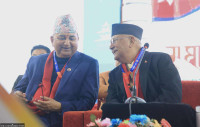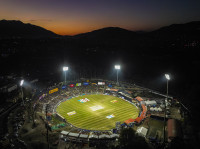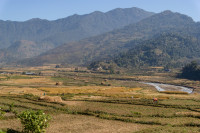Opinion
Opening the floodgates
We must invest sincerely in hydropower development, not just to meet domestic demand but also to export energy
Shital Babu Regmee
It is not that consumers are not trying to get electricity through various means. They are storing electricity in batteries, installing solar cells on rooftops and buying cheap lighting appliances, mostly imported from China. Industries, big hotels, hospitals, educational institutes and shopping malls all own diesel generator sets. A recent study showed that the total installed capacity of stand-by generator sets is about 750 megawatts, which is at par with the total hydropower capacity developed in Nepal till date. Consumers are paying about Rs 35 per unit for electricity thus generated.
All demand, no supply
The present suppressed demand for electricity in Nepal is about 1,200 megawatt and it is increasing at a rate of more than 10 percent per year. So resolving this problem of electricity crisis should be a serious concern.
Faced with such a grave situation and hungry for speedy development of hydropower, we also frequently hear about spill-energy and the associated losses with it in near future. But is it the time to worry about spill energy? Will the Nepal Electricity Authority be bankrupt due to the financial burden of spilled energy? These concerns should certainly be addressed properly to determine our future course on electricity development. But first, we need to assess our future electricity need .
Nepal’s import of diesel doubled to 600 million litres in a period of two years, from 2008 to 2010. At present, we spend all our export earnings and one-third more to just import petroleum products. The consumption of Liquefied Petroleum Gas (LPG) is increasing at a rate of almost 20 percent every year. A major portion of this increase is due to the use of diesel for electricity generation and LPG for domestic use. This could have been checked had we been able to produce sufficient electricity.
The present suppressed forecast indicates a more than 10 percent increase in demand each year. If we convert electricity generated by burning diesel and substitute LPG with electricity, it will add another 400 megawatt load throughout the year. So it is a valid assumption that if we have sufficient electricity, we will not need to burn diesel for generators and LPG for cooking, as it would be far cheaper for the consumer to use electricity instead. About 1,600 megawatt of electricity could be consumed at present if we had sufficient electricity generation. On top of that, we can substitute petroleum products with electricity by promoting electric vehicles and mass transport.
Rising demands
Experts suggest that our target of getting 8 percent GDP growth needs 12 percent growth in energy demand. This simple calculation establishes the fact that our present electricity demand of 1,600 megawatt needs to increase by an additional 12 percent every year. Let us be very optimistic and assume that if we are to cater to the demand, we need about 2,500 megawatt in five years. If we set a modest target of 6 percent, the total demand after five years would be 2,000 megawatt.
Nepal’s present day electricity production is 27 watt per capita. It is 90 watt for India and 440 watt per capita for China. To reach the level of present day India in five years, we need to develop about three and a half folds more electricity than our present installed capacity. This validates our assumptions.
Nepal has sufficient hydropower potential. Our theoretical potential of hydropower generation is about 900,000 gigawatt hours. With such a huge potential, we should have the target of addressing all feasible energy demand through hydropower. Our medium term target should be to produce sufficient electricity to meet the demand of most domestic, industrial and commercial energy needs in urban areas and basic needs in rural areas.
Plan big
The scenario of future electricity consumption shows that we need to develop at least 350 megawatt per year in the coming years with a big storage project of at least 500 megawatt capacity to address our yearly incremental need. If we develop only run-of-the-river systems, then even if we have sufficient installed capacity, loadshedding will prevail in the dry season. One other option may be construction of run-of-the-river systems and developing cross-border transmission lines of sufficient capacity and swap or trade electricity, exporting to India in summer and importing in winter. The other option may be developing power plants to cater to the needs of the dry period and using spill energy for fertiliser production or developing heavy industries that need electricity in huge quantities.
These facts indicate that it is not time for us to worry about spill energy. It is not going to happen in the near future. Our past performance indicates that our accomplishment is far less than our targets. We should, therefore, have ambitious plans for the future so that we can produce electricity to meet all our domestic needs for a high growth target in the future. If we entangle ourselves in the debate of spill energy, well, we may remain in perpetual darkness.
Electricity is raw material for many economic activities. And we have sufficient potential to produce electricity. But we often opt to spread our resources across different sectors and hydropower development ends up getting less priority than it needs. Our experience has taught us a lesson and we are slowly realising the importance of hydropower development in Nepal. The theme of the past used to be ‘hydropower is a lucrative sector and it should be developed by private investors’, which has not materialised in the past two decades. So the priority of the present government to invest local resources for the development of hydropower is praiseworthy. Nepal should invest in this sector and institutions involved in electricity development should be more efficient and increase their spending capacity. Let us declare the upcoming decade a ‘hydropower development decade’. And let us not only aim to meet the national demand, but also to export a sufficient quantity to make Nepal prosperous. Let us not define our electricity generation in the wet season as spill energy; if so, who will pay an appropriate price for a commodity that is going to be spilled?
Regmee is a former secretary at the Energy Ministry




 9.12°C Kathmandu
9.12°C Kathmandu










